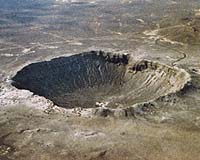How to destroy a meteorite
 In a famous film in 1998 called Armageddon, Bruce Willis and Ben Affleck destroyed a meteorite to save the world. Although this is just a sci-fi movie, the risk of a meteor hitting the Earth someday will come true. According to a researcher at Tel Aviv University, blowing away a meteorite is in fact more complicated than what's in the movie.
In a famous film in 1998 called Armageddon, Bruce Willis and Ben Affleck destroyed a meteorite to save the world. Although this is just a sci-fi movie, the risk of a meteor hitting the Earth someday will come true. According to a researcher at Tel Aviv University, blowing away a meteorite is in fact more complicated than what's in the movie.
Astrophysicists agree that the best way to avoid a catastrophic collision is to change the meteor's orbit toward the Earth. "In order for that to work, we need to be able to predict what will happen if we try an explosion," said PhD student David Polishook at Tel Aviv University.
Polishook and Borsch - Polishook support professors are among the few scientists in the world who are studying the structure and composition of meteorites - an important first step in studying the destruction of celestial bodies. agar before they can fly into Earth's atmosphere.
Their research can prevent catastrophes: destroying a meteorite can create many smaller pieces about 100 meters in diameter but also equally dangerous. A double-sized meteorite created the famous Barringer crater in Arizona. (Image)
"The information we are working on can have a huge impact on future plans to change the paths of meteorites," Polishook said.
"Science needs to know whether meteors are rocky parts or just piles of stones, what keeps them together and how to destroy them into pieces if exploded."
By observing the brightness of distant meteorites, Polishooks can check their shape, rotation time, and surface structure. "This is an effective method to evaluate the composition of meteorites."
As part of their observations, these researchers have applied the knowledge that small meteorites change their rotation rate, which can increase or decrease in short periods of time, usually every 100,000 years. Compared to the age of the solar system of 4.5 million years, it is a very fast change.
Recent results of the study came at the 2008 meteorite, comet and meteorite conference sponsored by Johns Hopkins University in Baltimore.
The rotation and acceleration of a meteorite is affected by sunlight "YORP" effect. If the YORP effect causes the meteorite to rotate faster than one turn in 2.2 hours, it will split into small parts.
To understand how the YORP effect affects meteorites, researchers at Tel Aviv University have looked at a number of parameters related to meteorites, including size and location. They came to the conclusion that size acts as the most important factor in determining the rotation speed of a meteorite according to the YORP effect.
The article was provided by reader Tran Ba Hoang Long
- NASA launched a meteorite research satellite that could destroy the Earth
- Meteors are not enough to destroy life on Earth
- The 5 largest meteors ever plunged to Earth
- Meteors are hard to destroy the earth
- Find the largest meteorite pieces in Russia
- Flocking to find meteorite fragments in Russia
- The meteorite explosions
- A meteorite as big as the Great Pyramid is about to fly over the Earth
- 9 ways to block meteorites
- What is Chondrit meteorite?
- The oldest meteorite is about the same age as the Solar System
- Strange meteorite split itself
 Van Allen's belt and evidence that the Apollo 11 mission to the Moon was myth
Van Allen's belt and evidence that the Apollo 11 mission to the Moon was myth The levels of civilization in the universe (Kardashev scale)
The levels of civilization in the universe (Kardashev scale) Today Mars, the sun and the Earth are aligned
Today Mars, the sun and the Earth are aligned The Amazon owner announced a secret plan to build a space base for thousands of people
The Amazon owner announced a secret plan to build a space base for thousands of people